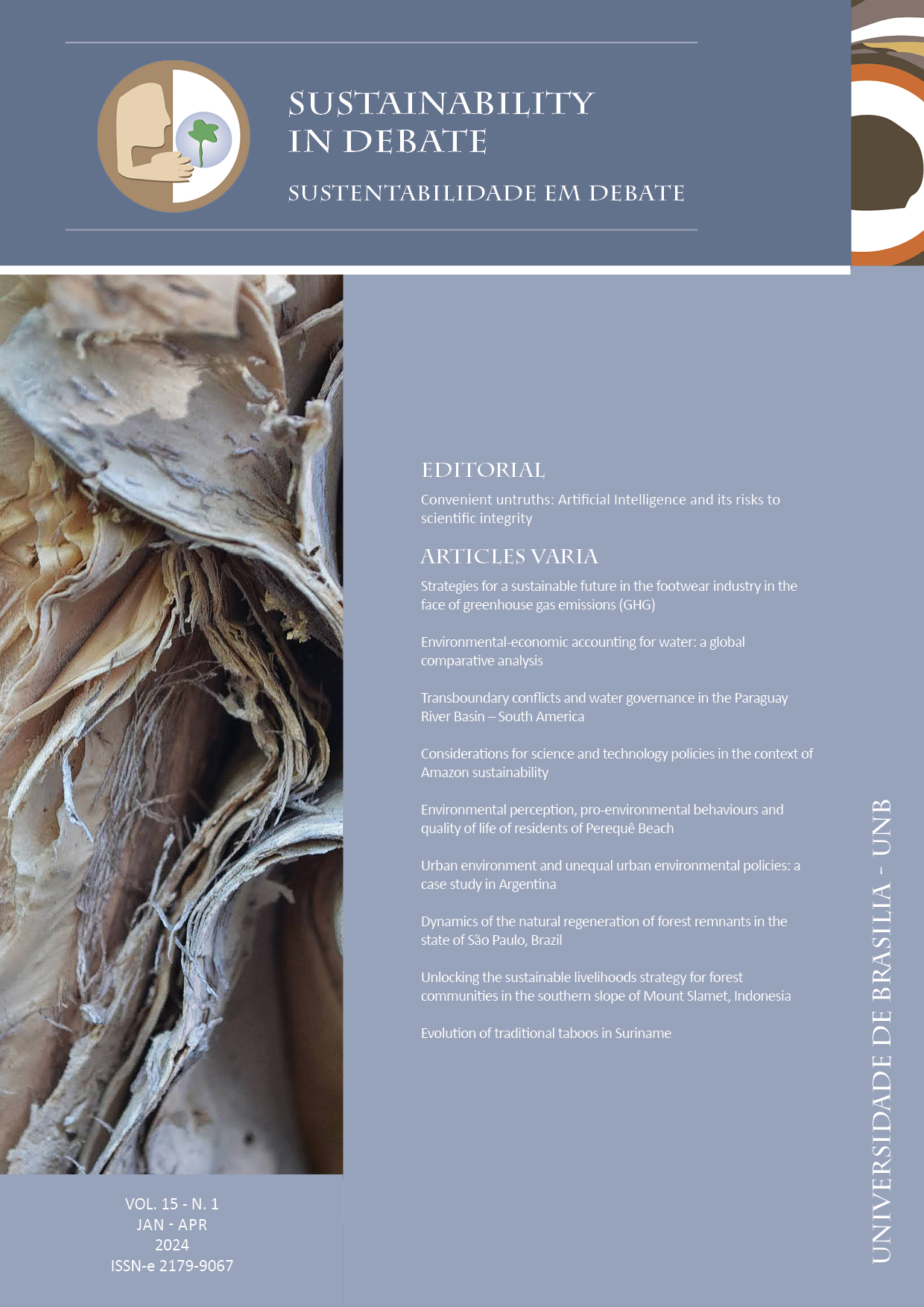Dynamics of the natural regeneration of forest remnants in the state of São Paulo, Brazil
DOI:
https://doi.org/10.18472/SustDeb.v15n1.2024.52288Palabras clave:
Forest restoration, Geotechnology, Change in land use and coverResumen
The main factors that favour the regeneration of native vegetation in two regions in southeast Brazil were evaluated over an approximate period of 30 years. Region 1 covers 5.2 million hectares and is situated in the northern and northeastern portions of São Paulo. Region 2, located in eastern São Paulo, is formed by the Paraíba do Sul River basin and spans over 1.4 million hectares. In 2016, the area of native forests in Region 1 accounted for 19.3% of the territory against 16.9% in 1988. In Region 2, forests expanded by 83%, from 250,000 to 455,000 hectares. However, while in Region 1, characterised by competition between agricultural crops, the forest gain was modest, in Region 2, marked by steep terrain and a decline in livestock activities, significant natural forest regeneration was favoured. Restoration of native forest vegetation in the state of São Paulo may vary significantly over regions.
Referencias
BICUDO DA SILVA, R. F.; MORA, N. E.; VIÑA, A.; MILLINGTON, J. D. A.; DOU, Y.; VIEIRA, S. A.; LOPEZ, M. C.; LIU, J. Toward a forest transition across the Brazilian Atlantic Forest biome. Frontiers in Forests and Global Change, v. 6, 2023. DOI: 10.3389/ffgc.2023.1071495.
BRANCALION, P. H. S.; GARCIA, L. C.; LOYOLA, R.; RODRIGUES, R. R.; PILLAR, V. D.; LEWINSOHN, T. M. A critical analysis of the Native Vegetation Protection Law of Brazil (2012): updates and ongoing initiatives. Natureza e Conservação, v. 14, n. S1, p. 141-15, 2016. DOI: 10.1016/j.ncon.2016.03.003.
CALABONI, A.; TAMBOSI, L. R.; IGARI, A. T.; FARINACI, J. S.; METZGER, J. P.; URIARTE, M. The forest transition in São Paulo, Brazil: historical patterns and potential drivers. Ecology and Society, v. 23, n. 4, 2018. DOI: https://doi. org/10.5751/ES-10270-230407.
CROUZEILLES, R.; FERREIRA, M. S.; CHAZDON, R. L.; LINDENMAYER, D. B.; SANSEVERO, J. B.; MONTEIRO, L.; IRIBARREM, A.; LATAWIEC, A. E.; STRASSBURG, B. B. Ecological restoration success is higher for natural regeneration than for active restoration in tropical forests. Science Advances, v. 3, n. 1, e1701345, 2017. DOI: 10.1126/sciadv.1701345.
FERREIRA, M. P.; ALVES, D. S.; SHIMABUKURO, Y. E. Forest dynamics and land-use transitions in the Brazilian Atlantic Forest: the case of sugarcane expansion. Regional Environmental Change, v.15, p. 365–377, 2015. DOI: 10.1007/s10113-014-0652-6.
GIGLIO, E.; LUIZ, A.; NAJBERG, E. As relações sociais como fatores determinantes na rede de implementação de políticas ambientais rurais: investigação a partir de alguns municípios do estado de São Paulo. Revista Desenvolvimento em Questão, v.11, n. 24, p.169-203, 2013. Available in: http://www.redalyc.org/articulo. oa?id=75229296007.
INHAMUNS, M. C.; DE SOUZA REZENDE, R.; COELHO, G. C. Restoring riparian forest in the Atlantic Forest: does planting seedlings make a difference? Restoration Ecology, v. 29, n. 4, e13356, 2021. DOI: https://doi.org/10.1111/ rec.13356.
LEITE, M. S.; SILVA JUNIOR, J. A.; CALABONI, A.; IGARI, A. T. Fatores socioeconômicos e a vegetação nativa em imóveis rurais no estado de São Paulo. Ambiente & Sociedade, v. 23, 2020. DOI: https://doi.org/10.1590/1809- 4422asoc20170309r3vu2020L1AO.
MOLIN, P. G.; GERGEL, E.; SOARES-FILHO, B. S.; FERRAZ, S. F. B. Spatial determinants of Atlantic Forest loss and recovery in Brazil. Landscape Ecology, v. 32, p. 857–870, 2017. DOI: https://doi.org/10.1007/s10980-017-0490-2.
MOLIN, P. G.; CHAZDON, R.; FERRAZ, S. F. B.; BRANCALION, P. H. S. Data from: a landscape approach for optimising the cost-effectiveness of large scale for restrestoration. Zenodo Digital Repository, 2018. DOI: https://doi. org/10.5281/zenodo.1256029.
NALON, M. A.; MATTOS, I. F. A.; FRANCO, G. A. D. C. Inventário da cobertura vegetal nativa do estado de São Paulo. São Paulo, SP: SIMA/IPA. 2022. 238 p. Available in: https://adobeindd.com/view/publications/a5aba10f- 0090-4109-ac1c-944c8260b1ff/57wk/publication-web-resources/pdf/INVENTARIOflorestal_livroFINAL.pdf.
NOVO, A.; JANSEN, K.; SLINGERLAND, M. The sugarcane e biofuel expansion and dairy farmers’ responses in Brazil. Journal of Rural Studies, v. 28, n. 4, p. 640-649. 2012. DOI: https://doi.org/10.1016/j.jrurstud.2012.07.004.
RONQUIM, C. C.; SILVA, R. F. B.; FIGUEIREDO, E. B.; BORDONAL, R. O.; TEIXEIRA, A. H. C.; COCHASRK, T. C. D.; LEIVAS, J. F. Carbon sequestrations sociated to the land-use and land-cover changes in the forestry sector in Southern Brazil. Proceedings of Spie, v. 9998, p. 1-14, 2016.
RONQUIM, C. C.; FONSECA, M. F. Avanço das áreas de cana-de-açúcar e alterações em áreas de agropecuária no interior paulista. Campinas, SP: Embrapa Territorial, 2018. p. 48. (Embrapa Territorial. Documentos, 123).
ROTHER, D. C.; VIDAL, C. Y.; FAGUNDES, I. C.; SILVA, M. M. da.; GANDOLFI, S.; RODRIGUES, R. R.; NAVE, A. G.; VIANI, R. A. G.; BRANCALION, P. H. S. How legal-oriented restoration programs enhance landscape connectivity? Insights from the Brazilian Atlantic Forest. Tropical Conservation Science, v. 11, p. 1-9, jul. 2018. DOI: 10.1177/1940082918785076.
RUDEL, T. K.; COOMES, O. T.; MORAN, E.; ACHARD, F.; ANGELSEN, A.; XU, J.; LAMBIN, E. Forest transitions: towards a global understanding of the land use change. Global Environmental Change, v. 15, n. 1, p. 23-31, 2005. DOI: https://doi.org/10.1016/j.gloenvcha.2004.11.001.
RUDORFF, B. F. T.; AGUIAR, D. A.; SILVA, W. F.; SUGAWARA, L. M.; ADAMI, M.; MOREIRA, M. A. Studies on the rapid expansion of sugarcane for ethanol production in São Paulo State (Brazil) using Landsat Data. Remote Sensing, v. 2, n. 4, p. 1057-1076, 2010. DOI: https://doi.org/10.3390/rs2041057.
SILVA, A. L.; DIOGENES, S. A.; FERREIRA, M. P. Landsat-Based Land Use change assessment in the Brazilian Atlantic Forest: forest transition and sugarcane expansion. Remote Sensing, v. 10, n. 7, 2018. DOI:10.3390/rs10070996.
SILVA, R. F. B.; MILLINGTON, J. D. A.; MORAN, E. F.; BATISTELLA, M.; LIU, J. Three decades of land-use and land- cover change in mountain regions of the Brazilian Atlantic Forest. Landscape and Urban Planning, v. 204, 2020. DOI: https://doi.org/10.1016/j.landurbplan.2020.103948.
SOLÓRZANO, A.; BRASIL, L. S. C. DE A.; DE OLIVEIRA, R. R. The Atlantic Forest Ecologica History: from pre-colonial times to the anthropocene. In: MARQUES, M. C. M.; GRELLE, C. E. V. (ed.). The Atlantic Forest: history, biodiversity, threats and opportunities of the mega-diverse forest. Springer International Publishing, p. 25–44, 2021. DOI: 10.1007/978-3-030-55322-7_2.
SPAROVEK, G.; BARRETTO, A.; BERNDES, G.; MARTINS, S.; MAULE, R. Environmental, land use and economic implications of Brazilian sugarcane expansion 1996–2006. Mitigation Adaptation Strategies Global Change, v. 14, n. 3, p. 285–298. 2009. DOI: 10.1007/s11027-008-9164-3.
VANCINE, M. H.; MUYLAERT, R. L.; NIEBUHR, B. B.; OSHIMA, J. E. F.; TONETTI, V.; BERNARDO, R.; DE ANGELO, C.; ROSA, M. R.; GROHMANN, C. H.; RIBEIRO, M. C. The Atlantic Forest of South America: spatiotemporal dynamics of remaining vegetation and implications for conservation. bioRxiv, 2023. DOI: https://doi. org/10.1101/2023.09.16.558076.
ZANINI, A. M.; MAYRINCK R. C.; VIEIRA, S. A.; CAMARGO, P. B.; RODRIGUES, R. R. The effect of ecological restoration methods on carbon stocks in the Brazilian Atlantic Forest. Forest Ecology and Management, v. 481, 2021. DOI: https://doi.org/10.1016/j.foreco.2020.118734.
Descargas
Publicado
Número
Sección
Licencia
Derechos de autor 2024 Sustainability in Debate

Esta obra está bajo una licencia internacional Creative Commons Atribución-NoComercial-SinDerivadas 4.0.
La presentación de la(s) obra(s) científica(s) original(es) por parte de los autores, como titulares de los derechos de autor de los textos enviados a la revista, de conformidad con la Ley 9.610/98, implica la cesión de derechos de autor de publicaciones impresas y/o digitales a la Revista de Sustenibilidad en Debate de los artículos aprobados para fines de publicación, en un único número de la Revista, autorizando también que la(s) obra(s) científica(s) aprobada(s) se divulguen de forma gratuita, sin ningún tipo de reembolso de derechos de autor, a través del sitio web de a Revista, para leer, imprimir y/o descargar el archivo de texto, a partir de la fecha de aceptación para publicación. Por lo tanto, los autores, al presentar los artículos a la Revista y, en consecuencia, la libre cesión de derechos de autor relacionados con el trabajo científico presentado, son plenamente conscientes de que no serán remunerados por la publicación de los artículos en la revista.Â
La Revista está licenciada bajo una licencia no comercial y sin derivaciones Creative Commons (No permite la realización de obras derivadas) 3.0 Brasil, con el propósito de difundir conocimientos científicos, como se indica en el sitio web de la publicación, que permite el intercambio del texto y el reconocimiento de su autoría y publicación original en esta revista.
Los autores pueden asumir contratos adicionales por separado, para la distribución no exclusiva de las obras publicadas en la revista Sustenibilidad en Debate (por ejemplo, en un capítulo de libro), siempre que se indique que los textos se publicaron originalmente en esta revista y que se menciona el DOI correspondiente. Se permite y incentiva a los autores a publicar y distribuir su texto online después de su publicación (por ejemplo, en repositorios institucionales o en sus páginas personales).Â
Los autores aceptan expresamente los términos de esta Declaración de Derechos de Autor, que se aplicará a la presentación si es publicada por esta Revista.









